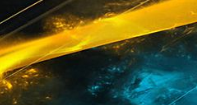在制备电子器件的过程中,传统的的光刻方法常需要用到光敏聚合物等有机材料涂覆在金属或半导体基底上进行正向或反向刻蚀或保护,然后再除去这些有机材料,这种方法制备工序非常复杂,尤其是在3D光刻构建三维结构的过程中。此外表面残余的有机物质还会对电子器件的电学性质和器件的稳定性等带来不利影响。而,今日Science报道了芝加哥大学的Yuanyuan Wang等人开发的一种全新的全无机材料直接光刻制备电子器件的方法。该方法具有适用性广,无残留,精度高等特性,并且大幅简化了传统的光刻工序,势必减少光刻成本。
Yuanyuan Wang等人利用具有光敏特性的有机小分子化合物结合在金属,半导体,氧化物等材料表面,再经光照后在表面产生的分解物种与材料表面离子结合后可以使得这些材料在极性或者非极性溶剂中具有不同溶解性物质,从而实现正向或反向光刻制备电子器件。如阳离子diphenyliodonium (Ph2I + ) ortriphenylsulfonium (Ph3S+ ),(PAGs)分解生成的H+;阴离子型ammonium1,2,3,4-thiatriazole-5-thiolate (NH4CS2N3, orTTT)分解形成的S或SCN-。
Fig. 1 Optical patterning ofnanoparticles with photosensitive inorganic ligands.
(A) Schematic representation of ananocrystalwith ion pair surface ligands. (B) Two complementaryapproachesto design of photosensitive inorganic ligands. Either cation (PAG+)or anion [1,2,3,4-thiatriazole-5-thiolate (CS2N3?)]of the ion-pair ligand can react under exposure to UV light. (C) CS2N3? grouphasa strong absorption band in the UV region (green line). This UV band ispresentin the absorption spectra of CdSe NCs capped with NH4CS2N3 ligands(red dotted line). An exposure to 254 nm light causes clean transformation ofCS2N3? to SCN? as confirmedby(inset) changes in the IR absorption spectra. (D) Colloidal solutionsofred-emitting CdSe/ZnS and green-emitting InP/ZnS quantum dots (QDs) andblue-emitting ZnSe/ZnS QDs capped with NH4CS2N3 ligandsdispersedin DMF. (E) Red (R)–, green (G)–, and blue-emitting (B) QDspatterned on SiO2substrate by using photoactive NH4CS2N3 ligandsand254 nm UV light with a 120 mJ cm?2 dose. (F) Atrue-color image containing ~8 × 105 RGB subpixels directlyphotopatternedby use of CS2N3?-capped QDs.Scale bars, 5 mm.
Fig. 2 Examples of optically patternedinorganic materials.
(A) Different materials patterned byusing PAG+-based ligands (CdTe, ZrO2, Fe2O3,and IGZO) and CS2N3? ligands (CdSe, InP,Au, and Al2O3). Scale bars, 100 μm (left column); 5 mm(right column). (B) CeO2 nanocrystals patterned on aglass substrate by using (Ph2I)2MoO4 ligands.Scale bar, 5 mm. (C) (Top) Positive patterns of CdSe/ZnS (red), InP/ZnS(green), and ZnSe/ZnS (blue) core-shell QDs patterned with NH4CS2N3 ligands.(Bottom) Negative patterns of oleate-capped InP/ZnS (red), CdSe/ZnS (green),and ZnSe/ZnS (blue) core-shell QDs patterned by using (p-CH3S-C6H4)(C6H5)2S+ OTf? (OTf,triflate) PAG. Scale bars, 5 mm.
这种光刻方法的精度与现有的方法不相上下,但是工序更加简单,如在6层光刻制备3D结构传统工艺需要43道工序,而这种全无机光刻方法只需要19道加工工序上。由于这些小分子化合物在溶剂中具有非常高的溶解性,因此可以在洗脱的过程中被完全去除,使得通过这种全无机光刻方法制备的电子器件在电学和光学上具有更加优异的性能。该方法完全可以作为现有光刻方法的替代方案。
Fig. 3 Typical pattern characteristics.
(A) A pattern formed by twosequentiallydefined layers of 10-μm-wide stripes of CdSe NCs patterned byusingNH4CS2N3ligands. (Inset) A magnifiedviewof the same pattern. (B) SEM image of an edge of a photopatternedlayerof CdSe NCs capped with NH4CS2N3 ligands.(C) 1951 U.S. Air Force target with one-micrometerresolution made ofopticallypatterned CdSe NCs with NH4CS2N3 ligands.(D) Height profiles of CdTe layers optically patterned by using the NCscapped with (Ph2I)2CdCl4 ligands. (E)Six layers of ZnSe/ZnS core-shell NCs sequentially patterned by using NH4CS2N3ligands.This three-dimensional pattern was created by using 19 process steps, whereastraditionalphotopolymer lithography requires 43 process steps (6).Scale bar, 5 mm. (Fand G) Height profile and opticalmicroscopyimage of a multilayer stripe pattern created by using CdSe NCs withNH4CS2N3 ligands. Scale bar, 50 μm.
Fig. 4 Properties of directly opticallypatterned semiconductor and dielectric materials.
(A) Photoluminescence spectrum ofpixelscomposed of red-, green-,and blue-emitting QDs patterned by using NH4CS2N3ligands.The emission spectra of corresponding QD solutions are shown as dashed lines.The excitation wavelength was 360 nm. (B) Dielectricconstant of Al2O3 layerpatternedby using NH4CS2N3 ligands. Themeasurementswere carried out for an Al/Al2O3/Al flatcapacitorwith a 125-nm-thick Al2O3 layer and anareaof 0.64 mm2. (Inset) A current-voltage relation (I-V)characteristic used to measure resistivityof the Al2O3 layer.(Cand D) Transfer and output characteristics of an FETwitha channel made of compositionally matched CdSe/Cd2Se32? ligandsandCdCl2 treatment (6). (Eand F)Transfer and output characteristics of a FET with an IGZO channel. The channellengthwas 30 μm, and the channel width was 180 μm.
Yuanyuan Wang,Igor Fedin, Hao Zhang, Dmitri V. Talapin. Direct optical lithography of functional inorganic nanomaterials. Science 28 Jul 2017:Vol. 357, Issue 6349, pp. 385-388 DOI: 10.1126/science.aan2958






评论列表